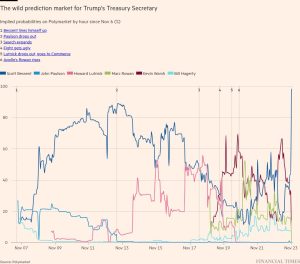After a month of fine dining, what have I learnt?
Unlock the Editor’s Digest for free
Roula Khalaf, Editor of the FT, selects her favourite stories in this weekly newsletter.
I realise that the past month’s columns may have looked a lot like public therapy. I really thought I could sort out my relationship with fine dining but each session just raised more questions. So in one last effort, I thought I should talk to other critics who’ve fallen out of love with it.
Tom Parker Bowles, critic for The Mail on Sunday, has just published a book on the history of aristocratic dining, so he’s sound on the historical roots of the phenomenon. “If you go back to Escoffier, fine dining should be about technique and brilliance in food and nothing else,” he says. It’s a noble idea, and simple, but does it still pertain?
Parker Bowles pinpoints the moment when he realised fine dining had turned on its head. Fifteen years ago on assignment in Paris for GQ, “Three stars, 22-course tasting menu. After about four hours, more and more courses, Chef [Alain] Ducasse came back and . . . it was this awful moment. I thought, this is supposed to be the pinnacle of gastronomy. I’ve never been so depressed. So insecure. So apologetic. And that was it. Enough now. I’m not doing it again.”
There was a strong class element to his discomfort — perhaps surprisingly, as he admits he “came in as a toff, a public schoolboy”. Yet he speaks with anger about the attitude in some places. “‘You don’t speak the right way.’ ‘We don’t want your type, you’re wearing trainers.’ I never liked those restaurants. I never liked being told, ‘This is how we do it’ and ‘Don’t you understand, sir?’ Immediately, my hackles would go up.”
To Jay Rayner, who has held down the critic’s beat at The Observer for 25 years, it’s of course “a class thing”, but that’s also created a shift in focus. “In the postwar period, it was still seen as somehow obscene to be spending large amounts of money on food and eating out. The only way that it could be relatable was if it came with a lot of bells and whistles. So it was not actually about the food on the plate. It was about the tablecloths and candelabras, and obsequious people.
“That’s why Terence Conran was so successful,” Rayner goes on. “He was an interior designer who turned design to restaurants. He brought all that aesthetic to it . . . everybody was happy to be distracted by the things that have nothing to do with food.”
But for a critic, the food is the point of the thing. We don’t need to prove status to anyone, and we don’t have to pay personally for access. We proudly don’t give a toss. We’re supposed to care about places that display creativity and divergent methods of service rather than box-ticking off a checklist. If we wanted that gig, we’d all work for Michelin.
Of course, if you read the critics, you’ll know we still review fine dining restaurants, though we seem to avoid using the term. Those who concentrate on and celebrate fine dining are either unpaid enthusiasts online or anonymous restaurant inspectors. A hermetic “special interest group” very different from the audiences to which national critics need to address themselves.
I went to Victor Garvey for a chef’s take. He runs Sola restaurant in Soho, a one-star with aspirations to more, and has spent a lifetime leading superb kitchens worldwide. His own cooking is breathtaking.
“Fine dining is where the diner has to do the least amount possible,” he says. “It assumes that you’re not going to have to pour your own water, your own wine. The food is going to be cut into pieces that are appropriate for taking a bite without having to sort through it too much with a knife. It’s about taking the effort out of the hands of the diner. Obviously, you need to set an expectation for your customers before they arrive. Tell them ‘fine dining’ and you’re saying, ‘Hey, don’t worry, kick back, you’re gonna get taken care of’ — as well as ‘Make sure your credit cards are ready.’”
This job has given me unusual exposure to fine dining and I can report that there are some bloody gorgeous restaurants operating under the banner, and some absolute dogs. The balance has been about 50/50. Of the restaurants making the claim, half of them fail to reach a standard they have entirely set themselves. And if it’s a coin-toss whether the “fine dining” promise on the door is or isn’t reflected by the experience inside, what’s the point?
For the promise of fine dining to be met, the food ought to be faultless, but not necessarily exciting. Not innovative. Not even emotionally charged. But the “pattern” of fine dining must be recognisable, expensive, complicated and difficult to replicate. It couldn’t be luxury if it was accessible or easy to execute. When I visited Kadeau in Copenhagen a few weeks back, arguably now one of the finest restaurants on the planet, the term “fine dining” didn’t appear anywhere on its communication. I am glad.
Has the therapy worked? No. I can’t rekindle a love of fine dining because I can no longer think of it as a meaningful category. I still have to walk past signs, read menus or look at websites that use the words, but I now realise I must ignore them. Because I care first about food and second about real, soul-deep hospitality. Because I’m lucky, or maybe jaded enough, that the status trappings are immaterial or, worse, might prejudice me against the place.
Critics have to either hate Fine Dining or ignore it when it’s promised. It’s the only choice we have.
Follow Tim on Instagram @timhayward
Follow @FTMag to find out about our latest stories first and subscribe to our podcast Life and Art wherever you listen
#month #fine #dining #learnt





